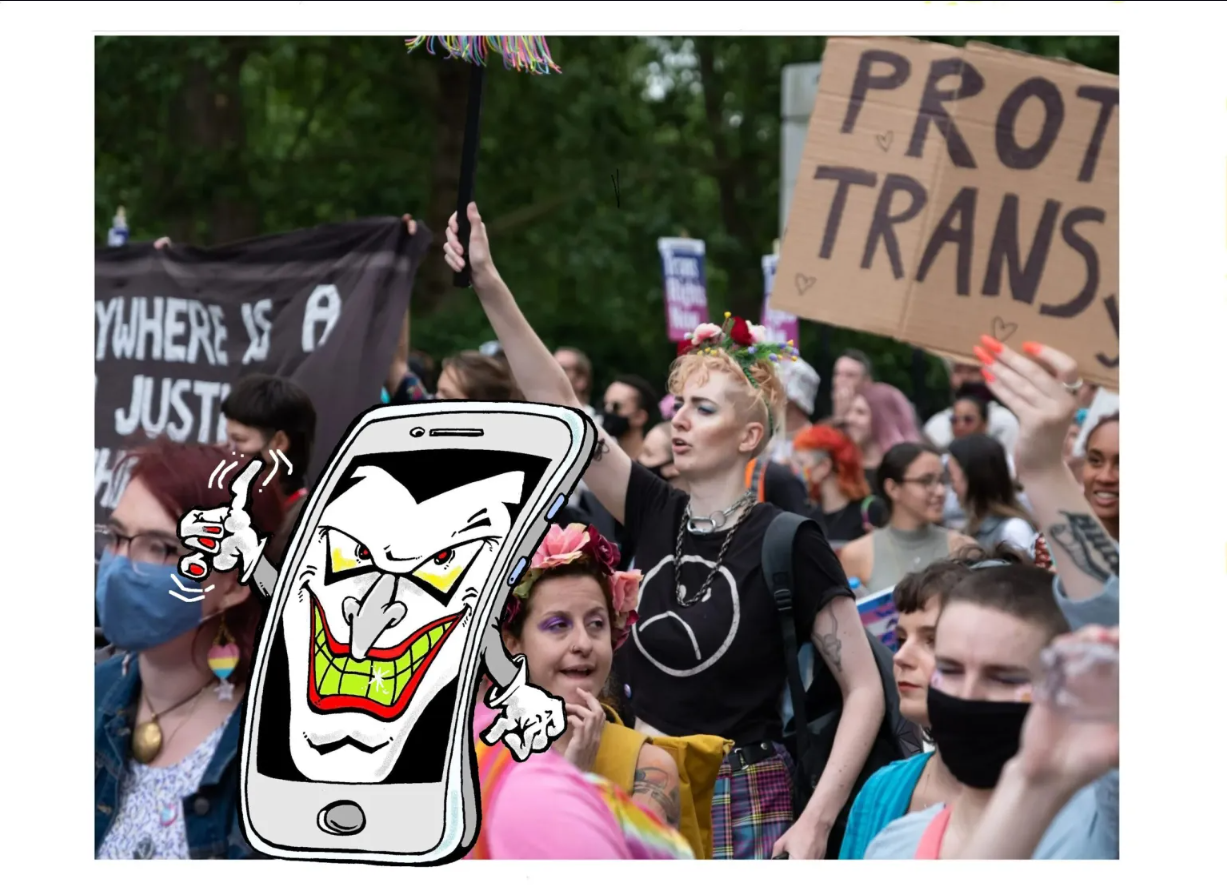
Social contagion is at least partially responsible for the upsurge in gender dysphoria in the past three decades, but this is vehemently denied by most social institutions charged with the safeguarding of children and young people, including governments, universities and schools, human rights commissions, legal institutions and sporting bodies.
The misguided adherence to a scientifically bankrupt gender ideology has had, as yet unfathomed, negative impacts on young people, their families and the wider society. The reason that this phenomenon is never debated is that it would detonate and topple the edifice of gender ideology.
The prevailing view regarding this unprecedented upsurge is that the social and cultural milieu into which the current generation of children and adolescents has been born has permitted disinhibition of expression of their transgendered identity in the same way that left-handedness and homosexuality were permitted freer expression in previous decades, hence leading to increased numbers of those “coming out”.
This explanation is unsatisfactory and alternate explanations for this 21st century phenomenon of gender dysphoria and transgenderism must be canvassed. Social contagion is the prime candidate.
What is social contagion?
The term “psychic epidemic”, now called social contagion, describes the “spread of phenomena (eg behaviours, beliefs and attitudes) across network ties”. Members of a network play different roles in the dissemination of innovations. A small number will adopt early (ie early adopters). Some of these will become opinion leaders who are central to the network, who contaminate their “peers” who in turn will influence others at different levels of the network. Networks with high centrality are the most effective in disseminating information or innovation.
Other characteristics of networks include cohesion (number of connections within a network) and shape (distribution of ties within the network). A key example with respect to this discussion are the gender-affirming organizations that have achieved remarkable success in a short time in changing health care, educational practices and legislation related to transgender-declaring young people.
With the arrival of Covid-19, the World Health Organization (WHO) warned that there would be an “infodemic” of misinformation spawned by social contagion. This did in fact occur, but those false beliefs did not take centre stage and sweep all science before it in the manner of transgender ideology because it was contained by responsible social and governmental bodies.
Not so for gender dysphoria.
What are the mechanisms of social transmission?
Social contagion in several adolescent behaviours (eg mood and emotion, eating disorders, drug use, self-harm and suicide) has been well established empirically. For example, Madelyn Gould concluded that
… the existence of suicide contagion no longer needs to be questioned. We should refocus our research efforts on identifying which particular story components promote contagion under which circumstances and which components are useful for preventive programming.
Four mechanisms that may be involved in the social contagion of these behaviours and gender dysphoria are:
- Peer contagion: Peer contagion is a process of reciprocal influence to engage in behaviours occurring in a peer dyad/group. By middle childhood, gender is the most important factor in the formation of peer associations, highlighting the significance of gender as the organizing principle of the norms and values associated with gender identity.
- Deviancy training as a mechanism of social contagion: A process whereby deviant attitudes and behaviours are rewarded by the peer group. Young people are particularly vulnerable to peer contagion if they have experienced peer rejection, hostility and/or social isolation from the peer group.
- Co-rumination as a form of social contagion: A process of repetitive discussion, rehearsal and speculation about a problematic issue within the peer dyad or peer group that underlies peer influence. It is more common among adolescent girls. Being in a friendship that engages in perseverative discussions on deviant topics has been associated with increased problem behaviour over the course of adolescence.
- Social media: Nathan and Kristina have argued that: “Unlike the broadcasts of traditional media, which are passively consumed, social media depends on users to deliberately propagate the information they receive to their social contacts. This process can amplify the spread of information in a social network.”
Targeted marketing campaigns on and offline generate additional influence. Peer influence and homophily (intrinsic peer similarity) are major factors influencing the behaviour of those embedded in social networks. Peer influence is more likely to trigger positive, self-reinforcing feedback loops, where the imitation of the target individual’s behaviour by peers enhances that behaviour in the target individual so that s/he does more of the behaviour which becomes more extreme over time, creating a social multiplier effect.
This effect also occurs in online communities which is enhanced by introducing certain features into the market design of products, such as, in this case, puberty blockade, cross sex hormones and sex reassignment surgery, and identifying the influential and susceptible users.
Online activity enables, enhances or triggers potential risks of “copycat” behaviours, such as self-harm, suicide and eating disorders through the normalization of pathological behaviours or vicarious and social reinforcement of these behaviours.
Is gender dysphoria socially contagious?
Given the strong evidence of social contagion in suicide, self-harm, substance abuse, eating disorders and emotion/mood, especially among adolescents, the role of social contagion in gender dysphoria demands urgent attention. There are already strong indicators in the affirmative. For example, positively framed media reports of transgender issues result in increases in referrals of self-declaring transgender and gender diverse (TGD) children and adolescents to specialist gender services.
If we examine the gender dysphoria epidemic in social network terms, we see several features operating. It is an open-system network with nodes and ties expanding across the oceans to the USA, UK, Asia, Europe, Scandinavia, Australia and New Zealand. Most countries are reporting sharp increases in the number of young people seeking services and treatment for gender dysphoria. Many are ramping up services and setting up new gender clinics to cope with demand, despite the recent closure of the Tavistock Gender Identity Service in the UK following the Cass review. This network is highly centralised with only one voice – unquestioning gender affirmation.
Opinion leaders of this position operating at the centre of these networks are very influential. The level of density in a network has two effects – firstly, it enhances the circulation of information between members and, secondly, it blocks the introduction of dissenting ideas and evidence.
Peer contagion may be a relevant factor in the sharp increases in young people presenting with gender dysphoria. There are a number of mechanisms.
Low gender typicality, peer victimization, ingroups and the “trans lobby”.* Low gender typicality (ie perceived lack of fit within one’s binary gender) has a significant impact on social acceptance within one’s peer group. As children progress to adolescence, peer as opposed to parental acceptance becomes paramount. Peers therefore take over the role of gender socializing agents from parents. Adolescent peers tend to be critical of behaviours, dress, mannerisms and attitudes that are not gender typical as a way of policing and reinforcing gender norms and respond with criticism, ridicule, exclusion and even intimidation of non-conformers.
Perhaps these groups of young people, searching for homophily (ie like peers), started to exaggerate their points of difference from their gender-conforming peers rather than to hide and minimize them to avoid being bullied and excluded. In so doing, they left the “outgroup” of nonconformers and formed an ingroup of extreme gender-nonconformers, transcending the gender barrier altogether and declaring themselves transgender. Suddenly, the discomfort and fear of not being gender typical becomes a virtue and rather than fearing the disapprobation of their peers, their open revolt in declaring themselves transgender is valorised by a politically powerful transactivist lobby.
Ingroups behave in stereotypical ways with respect to outgroups – they favour ingroup characteristics, assigning more positive attributes to its members and derogating outgroups in order to enhance the status of their ingroup.
It is not surprising, then, that members of the transgender ingroup exaggerate the characteristics of the “trans” gender they take on – becoming more “feminine” or “masculine” than heteronormative groups of men and women. Transactivist groups have proliferated and consolidated in a short time frame by exploiting the characteristics of ingroups and outgroups. For example, social projection (ie the belief that other members of the group are like oneself) has been a powerful integrating process that simultaneously creates protection for its own members and distance from outgroup members. Those disagreeing with the ideology of the trans lobby are labelled “transphobic” and publicly denounced.
Rapid onset gender dysphoria (ROGD) and the role of social media: There has been a disproportionate increase in the number of female adolescents, and a change in the historically greater ratio of preschool boys compared with adolescent girls in earlier decades. Rapid onset gender dysphoria (ROGD) figures from the Tavistock gender service in Britain 2019-2020 show a peak in presentations at 14-15 years, comprising mainly girls.
DSM 5 (2013) estimated prevalence at one in 10,000 males and one in 27,000 females. Now studies are frequently recording incidence of transgender young people at one to two per cent. Current adolescent estimates are between 140 (males) and 350 (females) times higher than that for transgender adult males and females. Social forces must be at play to account for this unprecedented overall rise and increase in female prevalence in transgender declarations over the past decade. Pang et al concluded that
… increased media content (specifically via social media) might act as a … means of social contagion, whereby some individuals erroneously come to believe through exposure to such media that their nonspecific emotional or bodily distress is due to gender dysphoria and being transgender/gender diverse (p 7).
Regret and detransition
Trangender proponents argue that social contagion is not at play because regret/detransition rates are low. However, Vandenbussche observed that the average time lag from transition to detransition was five years and that any study reporting on shorter time periods would underreport the true rates of detransition.
The 237 detransitioners in this study reported receiving no medical assistance with their medical detransition (eg how to safely stop cross-sex hormones) or with the complications arising from “gender-affirming” surgery. The majority reported lack of support and other negative experiences from their former treating medical and mental health professionals and from the LGBT+ community generally. The reason? They are bad publicity for transgender apologists.
A profiling study of 100 detransitioners reported that 70 per cent were white female college graduates, 56 per cent of whom reported experiencing pre-pubertal gender dysphoria. If gender dysphoria and gender transition are socially contagious, particularly among adolescent females, it would be expected that there would be a greater proportion of female detransitioners and this in fact the case. There was an average of four years between transition and detransition for the female participants.
Social contagion also affects doctors, professional bodies, legislators, courts, sporting bodies, educators and parents
Social contagion is by no means limited to vulnerable, suggestible children and adolescents. Social contagion has been documented in medical practice, professional bodies, law and legislation, sport, education, universities and politicians. We live in a “woke” society and have adopted a fearful herd mentality when it comes to speaking out against scientific fallacies like gender identity and the gender spectrum when personal loss is at stake.
Despite a lack of consensus internationally regarding safety, ethics, and benefit of the global trend to prescribe puberty blockade to increasingly younger patients, prescription of GnRHa has steadily risen over the past decade on the unfounded assumption that placing puberty on hold affords time for children to “decide” their “true identity”, while reducing suicide risk, although recent evidence confirms that puberty blockade conveys no benefit in reducing suicide and puberty blockade actually derails the normal developmental trajectory.
Many professional bodies that should be thought leaders appear less concerned about scientifically verifying their stances regarding the transgendering of young people and more concerned about falling foul of the dominant political stance of gender affirmation, since they rely in a circular manner on a small oeuvre of flawed transgender affirming “research” that is underpinned by the essentialist notion propagated by trans ideologues that gender, not sex, is primary.
According to DSM-5 (APA, 2013), 98 per cent of gender-confused boys and 88 per cent of gender-confused girls eventually accept their biological sex after naturally passing through puberty. However, the American Psychological Association (APA, 2015) and the Australian Psychological Society (APS) (2023) ignore the evidence in favour of appeasing an increasingly strident trans lobby.
Legal protections for children have been progressively eroded internationally, with the courts withdrawing from their gate-keeping roles and legislators being persuaded to mandate treatment of “transgender” children using only gender-affirmation pathways. They have also been successful in lowering the age at which young people can access sex re-assignment surgery without parental consent. Some courts have ruled that “a mature minor” is capable of giving consent to transgendering medical procedures.
Bills have also been passed allowing transgender people to change their birth certificates without undergoing sex-reassignment surgery. Under the legislation a person can self-nominate their sex and list as male, female or any other gender diverse or non-binary descriptor of their choice. Children can alter the sex on their birth certificate with parental support and a statement from a doctor or registered psychologist saying the decision is in the best interests of the child.
Medical, legal and human rights organisations have been acting synchronously (ie contagiously) to produce their position statements, denying the science of biological sex and abrogating their duty of care to young people. The Australian Human Rights’ Commission has provided guidelines about sports participation that clearly disadvantage natal females, and which may well have a profound effect on female participation in sport.
Education curricula internationally are introducing elementary school children to concepts like the gender fairy, the gender unicorn, the rainbow spectrum and the freedom to choose their gender. These biologically incorrect precepts are instilled unchallenged in vulnerable, receptive audiences, a clear demonstration that educationists have succumbed to social contagion to adopt these policies. School principals have discretion to socially transition children at school without their parents’ knowledge or permission, undermining parental authority and setting a dangerous precedent allowing children to make decisions about their wellbeing for which they are not prepared.
In Bostock vs Clayton County (2020), the US Supreme Court held that an employer who terminates an individual’s employment merely for being gay or transgender violates Title VII (p. 4–33). “Transgender” became a legally protected category for employment purposes. By analogy, this ruling implies that schools should treat trans students in a similar manner.
There are now strict policies within the police and media that there will be no reporting in the press or digital media of youth suicide. The reason: publication of the details of a suicide spawns copycat suicides in the same age groups of young people. So, there is no mention in the media of these tragic events. We are very aware as a society of the potential for social contagion in all our behaviours and the best way to stop the contagion is to remove social exposure.
When it comes to transgendering children and young people, it appears that we are unable to learn from history. As Ryan T Anderson (2018) concluded:
The [transgender] movement has to keep patching and shoring up its beliefs, policing the faithful, coercing the heretics and punishing apostates, because as soon as its furious efforts flag for a moment or someone successfully stands up to it, the whole charade is exposed. That’s what happens when your dogmas are so contrary to obvious, basic, everyday truths. A transgender future is not the “right side of history”, yet activists have convinced the most powerful sectors of our society to acquiesce to their demands. While the claims they make are manifestly false, it will take real work to prevent the spread of these harmful ideas.
Fortunately, and belatedly, social contagion can serve a positive function in this debate. A class action of 1000 families treated by the Gender Identity Disorder Service at the Tavistock Clinic in London has just been announced. This will be the first of many class actions against gender clinics as the long-term devastation wreaked by the worst medical experiment in history unfolds.
* I use this shorthand term to describe the multitude of organizations that have policies and practices associated with unquestioning gender affirmation









